ACQUITY UPLC-TUV Determination of Three Bovine Whey Protein Contents in Milk Powder and Milk Zhao Shujun Waters Technology (Shanghai) Co., Ltd. Abstract: One α-cow whey protein and two β-cow whey protein standards were diluted with ultrapure water, separated by ACQUITY UPLC BEH300 C18 column and detected by ACQUITY UPLC-TUV ultra performance liquid chromatography. The three whey proteins Bα-La, Bβb-Lg and Bβa-Lg were isolated at baseline, with a linear range of 1.000-100.000 mg/kg and a complex correlation coefficient of R2_0.999. The detection limit of the method was 1.000 mg/kg. Key words: ultra performance liquid chromatography milk powder milk bovine whey protein Bα-La Bβb-Lg Bβa-Lg Foreword experimental method Materials, reagents and instruments Acetonitrile is chromatographically pure, trifluoroacetic acid is pure grade, Triton X-100, sodium chloride (excellent grade pure), experimental water is ultrapure water (18MΩ, TOC3ppb), and bovine whey protein standard Bα -La, Bβb-Lg and Bβa-Lg; ACQUITY UPLC® Ultra Performance Liquid Chromatography System with Acquity TUV Detector, FILTER MIXER (425 μl, P/N 205000403). Data processing system Pretreatment method Weigh 0.20 g milk powder sample or 2 ml liquid milk sample, add 8 mL (6 ml for liquid milk) 0.3 M sodium chloride (containing 0.2% Triton X-100) solution, mix and shake; then use 0.3% The aqueous solution of TFA is adjusted to a pH between 4.4 and 4.6 (to precipitate casein with an isoelectric point of 4.6, pH needs to be carefully controlled, since the isoelectric point of whey protein is 4.8), to a volume of 10 mL, homogenized After 5 minutes, the mixture was allowed to stand at room temperature for 1 hour, left, centrifuged at 2500 rpm for 10 minutes, and the supernatant was passed through a 0.2 um filter. Results and discussion The standard preparation of three whey protein standards are diluted with ultrapure water, and prepared into different concentrations of standards for detection, which can obtain better peak shape and simple preparation. Whey protein has UV absorption at both 220 nm and 280 nm. Two whey proteins (concentration of 5 ppm) were selected at two wavelengths. It was found that although the analyte had the largest UV absorption at 220 nm, It also has high baseline noise and interference at the wavelength, so we chose 280nm as the detection wavelength to reduce the baseline interference in the mobile phase, as shown in Figure 4, the standard chromatogram of 5ppm. Flow rate, mobile phase optimization The actual sample detection found that there were more impurity peaks in front of Bα-La in the sample. Therefore, in order to prevent the interference of Bα-La in the low-retained impurities in the actual sample, the retention time of the liquid phase method Bα-La in Fig. 5 was adjusted. (As shown in Figure 4), B?b-Lg and B?a-Lg still have a resolution of 2.22. Linear correlation and detection limit of the method Pre-processing method discussion Actual sample test results From Figure 14, the overlapping chromatograms of the three whey protein standards, the actual sample, and the blank solution of the sample extract, it can be seen that in the milk powder and milk extraction solvent, there is no whey protein analyte in the sample. Interference. See also Figure 15 below for a chromatogram of the final addition of the standard for the milk and milk samples to further characterize the presence of the three whey proteins in the milk extraction sample. At the same time, it was found that the whey protein standard was filled with water or sample extract (containing Triton X-100 NaCl solution), and the injection test had no effect on the peak areas of the three whey proteins. Figure 16 shows the two standard solutions. Overlapping chromatogram of the product. At the same time, it was found that the whey protein standard was filled with water or sample extract (containing Triton X-100 NaCl solution), and the injection test had no effect on the peak areas of the three whey proteins. Figure 16 shows the two standard solutions. Overlapping chromatogram of the product. Reproducibility in conclusion This paper established a quantitative analysis method for the detection of Bα-La, Bβb-Lg and Bβa-Lg three kinds of bovine whey protein in the actual samples of milk powder and milk by Waters UPLC-TUV system. The detection limit of the method was 1 μg/g. Using the Waters ACQUITY UPLCBEH300 C18 column and the trifluoroacetic acid additive mobile phase, the Bβb-Lg and Bβa-Lg genetic variants can achieve baseline separation; using the 280nm detection wavelength, the mobile phase interference under low-wavelength detection is effectively reduced. It can be used to determine the content of three kinds of bovine whey protein in milk powder and milk. references 3D Hd Surgery Broadcast System 3D Hd Surgery Broadcast System,Medical 3D Hd Broadcast System,3D Surgery Broadcast System,Hospital Surgery Broadcast System NANJING TIANAO MEDICAL INSTRUMENTS MANUFACTURE CO.,LTD. , https://www.tianaomedical.com
Whey protein is the main protein in milk. The whey protein mainly includes α-galactin (Bα-Lactalbumin, Bα-La), β-bovine lactoglobulin (Bβ-Lactoglbulin, Bβ-Lg), protease-胨 and bovine serum. Albumin, etc., the former two are the main components of whey protein, which account for 10-20% and 40-50% of the total, respectively. β-bovine lactoglobulin includes two genetic variants of Bβb-Lg and Bβa-Lg. [1-2]
Whey protein has high nutritional value, easy digestion and absorption, and contains many active ingredients. It has been used more and more in the food industry. There are different types and brands of whey protein health products, such as children. Nutritional protein powder, infant formula, etc. [3]. However, it has been reported that whey protein is a common allergen, and β-lactoglobulin is the most important allergen, followed by α-lactalbumin [4]. UPLC can perfectly separate three whey proteins, Bα-La, Bβb-Lg and Bβa-Lg, with its 1.7μm ultra-fine packed column and 15000psi ultra-high performance liquid chromatography system; especially for Bβb-Lg and Bβa-Lg Two genetic variants allow complete separation. And with a highly sensitive Waters ACQUITY TUV UV detector, the entire system detects three whey protein detection limits up to 1ppm. The detection method can be applied to the quantitative detection of α-galactoalbumin and β-bovine lactoglobulin in milk or milk powder. 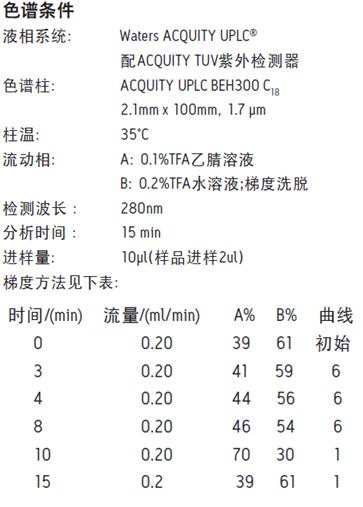
Empower 2 Chinese version
Selection of Detection Wavelengths Ultraviolet absorption spectra of three whey proteins were obtained by scanning with a Waters PDA detector, as shown in Figures 1-3. 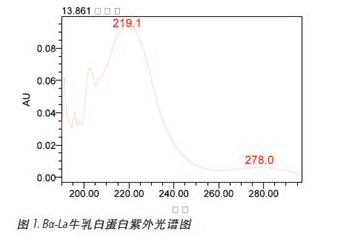
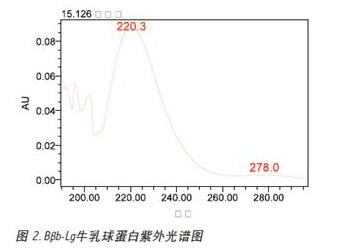


As shown in Figure 4, the chromatograms of the three bovine whey protein mixing standards are Bα-La, Bβb-Lg and Bβa-Lg according to the retention time. For high molecular weight protein analysis, the ACQUITY UPLCBEH300 C18 column with a waters aperture of 300 进行 is used. Separation, in addition, considering the mass transfer characteristics of macromolecular proteins, a smaller flow rate is required to achieve better separation. In this paper, three flow rates of 0.1ml/min, 0.2ml/min and 0.3ml/min were tested. The dead time of 0.1ml/min reached 2.5min. The overall peak time was later, the peak width was increased, and the final peak shape and fast sum were finally obtained. Separation is considered to select a flow rate of 0.2 ml/min as shown in FIG.
Under the current analysis conditions, Bα-La has a good retention, and then changes the mobile phase ratio to obtain four calibration chromatograms of the standard (Fig. 5). It can be seen from the figure that Bβb in the chromatogram of No.1 -Lg and Bβa-Lg two genetic variants achieved perfect separation (separation = 2.79); with the change of gradient, gradually accelerate Bβb-Lg and Bβa-Lg while maintaining the retention time of Bα-La At the peak time, the resolution of the two compounds gradually changed to 1.97 (Chromatogram No. 4), and the sensitivity was also slightly increased. However, considering the analysis of the actual sample, reduce the interference of the possible impurities on the analyte, this paper uses the No. 1 chromatogram gradient method for detection.

Three whey protein standards with concentrations of 1.000, 5.000, 50.000, and 100.000 mg/L were injected sequentially, and the injection volume was 10 μL, which was quantified by external standard method. Linear regression is performed with the peak area A as the ordinate and the concentration C as the abscissa. The Bα-La linear equation A=2.34e3×C-2.36e3, the complex correlation coefficient R2=0.9997, and the Bβb-Lg linear equation A=1.32e3 ×C-1 . 3 0 e 3 , complex correlation coefficient R 2 = 0. 9 9 9 5 ; B a - L g Linear equation A = 1.24e3 × C-1.36e3, complex correlation coefficient R2 = 0.9987. The three whey proteins have a good linear relationship in the range of 1.000-100.000 mg/L (as shown in Figures 6-8). And the experimental detection limit, the method detection limit is 1.000 mg / kg, Figure 9 is 1.000 mg / L three whey protein standard chromatogram, the concentration of Bα-La, Bβb-Lg, Bβa-Lg signal to noise ratio reached 8 3, 3, where Bα-La can achieve quantitative requirements. 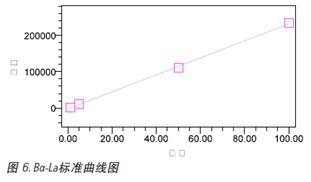

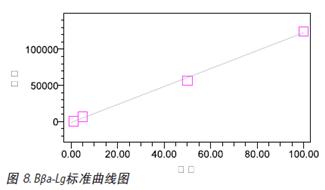
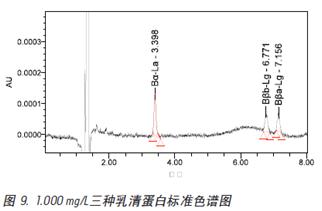
There are several points of attention in the pretreatment. The first is to use 0.3M NaCl extract containing 0.2% TritonX-100, try not to exceed 3 days, because the experiment found that the extraction and stabilization effect of the solution on whey protein will decrease after 3 days. . Next, the sample is added to the extract, and it needs to be placed for more than 50 minutes after adjusting the pH. Because the sample placed and unplaced is found to have a large difference in the degree of filtration when the membrane is filtered after centrifugation, it is easier to filter the membrane without being placed. However, the whey protein extraction rate is lower. The key point is also the mastery of the pH value of the extract. In this paper, the extraction of the same milk powder product at different pH is compared. As shown in the figure below, the pH is not much different between 4.4 and 4.6, but the pH reaches 4.8 and At 5.0, the peak shape of Bβb-Lg and Bβa-Lg deteriorated, especially the peak position of Bα-La was completely submerged by impurities. Therefore, it is necessary to control the pH value not to exceed 4.6 in the experiment.
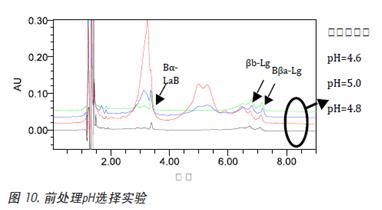
Figure 11-13 shows the chromatograms and results of the actual samples of two kinds of milk powder and one liquid milk.
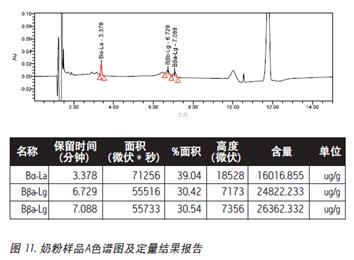
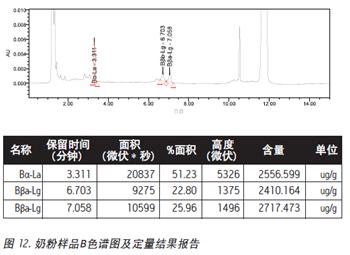
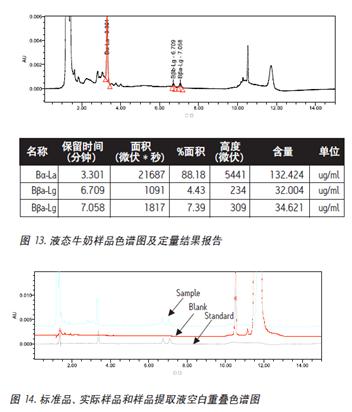
From Figure 14, the overlapping chromatograms of the three whey protein standards, the actual sample, and the blank solution of the sample extract, it can be seen that in the milk powder and milk extraction solvent, there is no whey protein analyte in the sample. Interference. See also Figure 15 below for a chromatogram of the final addition of the standard for the milk and milk samples to further characterize the presence of the three whey proteins in the milk extraction sample.

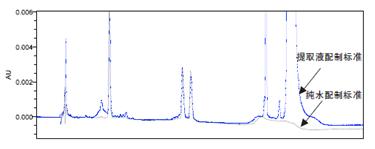
The overlapping chromatograms and reproducibility results for the eight injections of the 5 ppm standard are as follows:
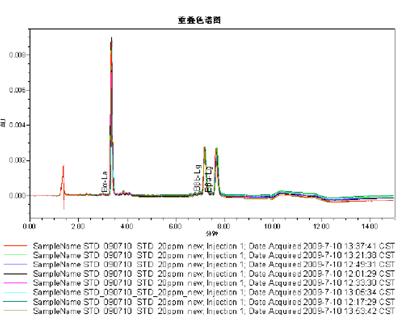
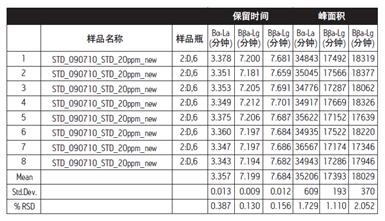
[1] Kinghorn NM, Norris CS, Paterson G R. Chromatogr A, 1995, 700: 111
[2] Cai Zengxuan, Chu Xiaojun et al. Proceedings of the 17th National Chromatography Academic Conference and Instrument Exhibition Conference, KB02: 23-24
[3] Li Hui, Chen Min et al. Chromatography. 2007.1, 25: 116-117 [4] Ena JM, van Beresteijn ECH, Robben AJPM, Schmidt D GJ Food Sci, 1995, 60(1): 104